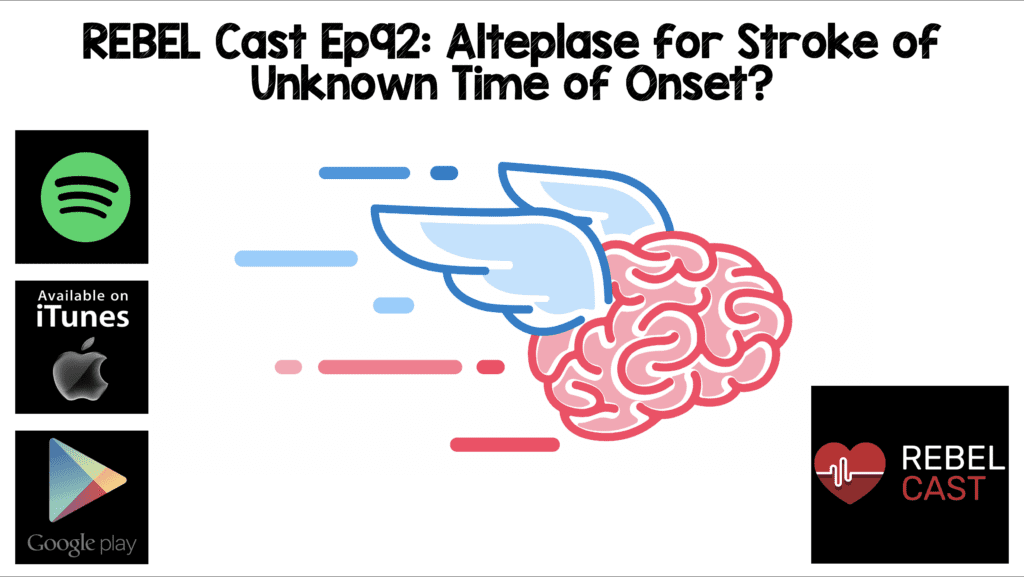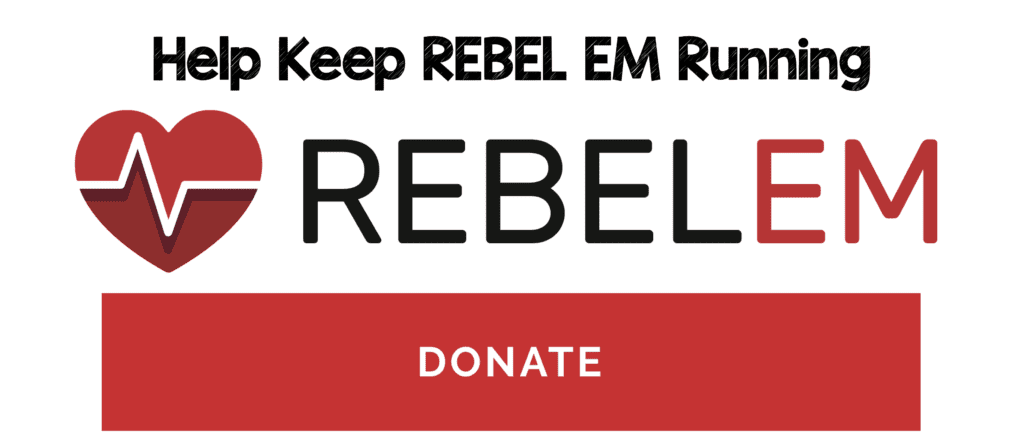
REBEL Cast Ep92: Alteplase for Stroke of Unknown Time of Onset?
Paper: Thomalla G et al. Intravenous Alteplase for Stroke with Unknown Time of Onset Guided by Advanced Imaging: Systematic Review and Meta-Analysis of Individual Patient Data. Lancet 2020. PMID: 33176180
Clinical Question: Is thrombolysis safe and effective in patients with unknown time of onset of stroke when salvageable brain tissue has been identified with advanced imaging?
What They Did:
- Systematic review and meta-analysis of individual patient data for trials published before Sept 21, 2020
- Randomized trials of intravenous alteplase versus standard care or placebo in adults with stroke of unknown time of onset and perfusion-diffusion MRI, perfusion CT, or MRI with diffusion weighted imaging-fluid attenuated inversion recovery (DWI-FLAIR)
Outcomes:
- Primary: Favorable functional outcome (Score of 0 to 1 on the mRS) at 90d
- Secondary:
- mRS shift towards a better functional outcome
- Independent outcome (mRS 0 to 2) at 90d
- Safety:
- Death
- Severe disability or death (mRS 4 to 6)
- Symptomatic ICH
Inclusion:
- Randomized trials comparing alteplase vs standard care or placebo
- Adults ≥18 years of age
- Acute ischemic stroke and unknown time of symptom onset
- Patients had advanced brain imaging with either penumbral imaging (i.e. perfusion-diffusion MRI or perfusion CT) or MRI-based tissue-clocking (i.e. DWI-FLAIR mismatch)
- Studies with more than 20 patients enrolled
Results:
- 4 trials met eligibility criteria (843 patients could have meta-analysis performed)
- WAKE-UP 503 patients using 0.9mg/kg alteplase
- Terminated early due to cessation of funding
- EXTEND 225 patients using 0.9mg/kg alteplase
- Terminated early due to results of WAKE-UP
- THAWS 131 patients using 0.6mg/kg alteplase
- Terminated early due to results of WAKE-UP
- ECASS-4 119 patients using 0.9mg/kg alteplase
- Terminated early due to lack of recruitment
- All 4 trials stopped early
- WAKE-UP 503 patients using 0.9mg/kg alteplase
- Baseline Characteristics of Note:
- Waking Up with Symptoms: 89.0%
- Median NIHSS Score: 7
- Large Vessel Occlusion: 25%
- Median Time from Symptom Recognition to Treatment Initiation: 3.3h
- Median Time Between Last Seen Well and Treatment Initiation: 10.6h
- Favorable Functional Outcome (mRS 0 to 1) at 90d (Primary Outcome):
- Alteplase: 47%
- Control: 39%
- aOR 1.49; 95% CI 1.10 to 2.03; p = 0.011
- NNT = 12
- Alteplase was associated with a significant shift towards better functional outcome (aOR 1.38; 95% CI 1.05 to 1.80)
- Alteplase was associated with higher odds of independent outcome (aOR 1.50; 95% CI 1.06 to 2.12; p = 0.22)
- Alteplase was associated with less patients who were dependent or had died (mRS 3 to 6) at 90 days (aOR 0.67; 95% CI 0.47 to 0.94; p = 0.022)
- Severe Disability or Death (mRS 4 to 6) at 90d
- Alteplase: 21%
- Control: 25%
- aOR 0.76; 95% CI 0.52 to 1.11; p = 0.15
- Death at 90d:
- Alteplase: 6%
- Control: 3%
- aOR 2.06; 95% CI 1.03 to 4.09; p = 0.40
- Of the 27 deaths in the alteplase group, seven were attributable to symptomatic ICH
- Of the 14 deaths in the control group, all were of non-neurological cause and unrelated to treatment or index stroke
- Symptomatic ICH:
- Alteplase: 3%
- Control: <1%
- aOR 5.58; 1.22 to 25.50; p = 0.024
Strengths:
- Searched multiple databases for eligible articles: PubMed, Web of Science, SciELO, LILACS, clinicaltrials.gov, EU Clinical Trials Register etc
- Meta-analysis of randomized clinical trials with individual patient data
- Asks a clinically important question in patients previous excluded from stroke trials
- Patient level data allows for quantification of the benefits and risks of intravenous alteplase
- Subgroup analyses did not identify a significant treatment heterogeneity and confirmed a consistent treatment effect across a wide range of patients
- Protocol for the study was prespecified and followed PRISMA guidelines for meta-analyses
- No funding source for this study
- Baseline characteristics appear to be fairly balanced between groups including number of patients waking up with symptoms, median time between last known well and symptom recognition, comorbid conditions, median NIHSS score and vessel occlusion on baseline CT- or MR-angiography
- Vessel imaging included a DWI-FLAIR mismatch and penumbral imaging looking for small infarct cores surrounded by a larger area of critically hypoperfused tissue with MRI or CT. This increases generalizability as either type of imaging is more effective than non-contrast head CT at identifying patients with potential for improvement
Limitations:
- All 4 trials stopped early and only had modest sample sizes which limits the strength/precision of the findings and can overestimate benefit of the individual trials
- Only one study used 0.6mg/kg of intravenous alteplase and therefore no definitive conclusions can be made about lower dosing vs higher dosing from this meta-analysis
- Due to the overall small sample size of 843 patients, the study was not powered to provide treatment effect estimates for smaller subgroups. This can also be seen in the wide 95% Cis for some of the subgroup analyses
- Most patients in this meta-analysis had mild to moderate strokes to begin with (median NIHSS score of 7) and therefore the results may not be generalizable to patients with more severe strokes
- 60% of the patients included in this meta-analysis were from the WAKE-UP trial
- The requirement of advanced imaging beyond non-contrast CT and vessel imaging might still be a potential limitation for implementation in some regions
Discussion:
- Both WAKE UP and EXTEND were started before compelling evidence for stroke thrombectomy was available for large vessel occlusion strokes and patients in which thrombectomy was planned were also excluded
- Overall risk of bias amongst included studies was low
- The availability of perfusion imaging can affect all stroke care, where time is no longer brain. There will be plenty of patients who present <3 hours with no penumbra and no mismatch. This group may not require thrombolysis and perfusion imaging can help confirm that and spare them the potential harms
- Authors found a fifth study (MR WITNESS) which was not a RCT but met all the other eligibility criteria
- They included the analysis with these results in the supplementary appendix
- This increased the number of patients up to 923 for analysis
- Favorable Neurologic Outcome (mRS 0 to 1) at 90d
- Alteplase: 46%
- Control: 39%
- Death at 90d
- Alteplase: 7%
- Control: 3%
- Severe Disability or Death (mRS 4 to 6):
- Alteplase: 22%
- Control: 25%
- Symptomatic ICH:
- Alteplase: 2%
- Control: <1%
- One thing to consider in this study is that despite having a lower number of deaths in the control group (mRS 6) compared to alteplase there were far more patients who were bedridden (mRS 5). This is a tough one to wrestle with from a patient care standpoint. Do we save a life at the expense of being bedridden or do we spare the patient being bedridden at the expense of death?
- DWI-FLAIR mismatch requires MRI which may not be feasible at every institution. In centers where it is available, DWI-FLAIR mismatch allows for treatment of patients with lacunar strokes. These patients would not have met criteria for a relevant amount of salvageable tissue in perfusion-based penumbral mismatch imaging.
- Penumbral mismatch imaging might identify patients with salvageable tissue despite already marked hyperintensity on FLAIR and potentially increases the number of patients given thrombolysis
- The authors also make note that in patients with large vessel occlusion, treatment with alteplase prior to thrombectomy showed treatment benefit (OR 2.35; 95% CI 1.04 to 5.32). We have covered this issue on REBEL EM, with our review of the DIRECT-MT trial. The conclusion of that trial was that in patients who can immediately be taken for endovascular intervention, systemic thrombolysis is not necessary
Author Conclusion: “In patients who have had a stroke with unknown time of onset with a DWI-FLAIR or perfusion mismatch, intravenous alteplase resulted in better functional outcome at 90 days than placebo or standard care. A net benefit was observed for all functional outcomes despite an increased risk of symptomatic intracranial haemorrhage. Although there were more deaths with alteplase than placebo, there were fewer cases of severe disability or death.”
Clinical Take Home Point: This meta-analysis provides level 1a evidence for the use of advanced brain imaging beyond non-contrast CT to help guide treatment with intravenous alteplase in patients with acute ischemic stroke with an unknown time of onset. However, despite a consistently better functional outcome at 90d with alteplase compared to placebo or standard of care there was still an increased risk of symptomatic intracranial hemorrhage and a higher mortality which has also been consistent across all randomized clinical trials.
References:
- Thomalla G et al. Intravenous Alteplase for Stroke with Unknown Time of Onset Guided by Advanced Imaging: Systematic Review and Meta-Analysis of Individual Patient Data. Lancet 2020. PMID: 33176180
Post Peer Reviewed By: Anand Swaminathan, MD (Twitter: @EMSwami)





